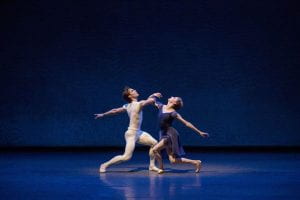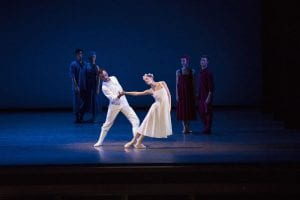
The September 25 evening program of the New York City Ballet’s fall season opened with Opus 19/The Dreamer, set to Prokofiev’s Violin Concerto No. 1 in D major, the composer’s first violin concerto and often referred to as “music in technicolor.” So, too, Jerome Robbins’ colorful dance, with lead couple Tiler Peck and Gonzalo Garcia, and a corps of twelve costumed in purple hues. Kurt Nikkanen performed demanding violin solo.
Peck and Garcia deserve accolades for their unforgettable dancing, but it is Tiler Peck who has singular musicality. In one of my Dance Magazine stories (7/17/17/ https://www.dancemagazine.com/dance-musicality-2457501371.html), Peck acknowledged the importance of music in her dance. She is, in fact, the epitome of musicality, feeling as much as hearing the music—and it’s obvious in the way she moves, as if in response to the music. But, both principals take risks, playing with weight shifts, sinking into movements, then lifting quickly out of them for a virtuoso move or turn. Tiler leans into her timing, working off the music, making the movements looked “marked,” easy, just as Jerome Robbins liked it. Opus 19/The Dreamer is a very romantic ballet, exciting, full of dynamics, crazy turns, sweet bourrée. The proficient ensemble appears like modern-day sylphs, moving in and out of Peck and Garcia’s reverie.
Mauro Bigonzetti’s Amaria is his fifth work for the company, set to sonatas by Scarlatti (the solo piano on stage is skillfully played by Craig Baldwin), and created for Maria Kowroski’s final season dancing with the company. The pas de deux has a raw feel, but somehow the dancers make it look melodic, albeit a bit morose and plodding. In a sense, the moves are skeletal, something very basic, the dancers completely exposed. As Amar Ramasar and Kowroski dance together, you feel their individual isolation, a soul-searching that ends with the dancers wrapped around each other. The only way through this is together.

Russian Seasons was choreographed by Alexei Ratmansky originally for the Diamond (new choreography) Project. Set to music by Leonid Desyatnikov, the piece is about connection and loss. Highlights are Kurt Nikkanen’s expert solo violin and soprano vocalist Veronica Mitina’s lush tone; the costumes, too — Slavic-esque tunics, long, loosely-fitting smock dresses empire-style. In the ballet, principals Sterling Hyltin, Sara Mearns, Taylor Stanley, Joseph Gordon, and Andrew Veyette shine. Ritualistic in parts, it references the motifs of the Orthodox Church.
Meant to be evocative of the four seasons, in this piece there is really only light and dark. Soloists Ashley Laracey, Indiana Woodward, and Sebastian Villarini-Velex, and corps dancers Laine Habonny, Alexa Maxwell, Andres Zuninga, and Jonathan Fahoury help to deliver both the ballet’s somber and lighter shadings and tone. From the principals, joy (delivered by the brilliant Hyltin) and angst (managed beautifully by Mearns) play out against each other. And that’s just it, this piece is about levity, as well as fatality.
Hyltin earns special recognition for her spirited balances, her entire demeanor one of awe and exploration. Mearns, with her torment-filled gyrations brings a vulnerability, but also a sense of turmoil, to the piece. The spry Hyltin and the troubled Mearns each provide strong points of view. But it is Stanley who is the heartbeat of the ballet, with his authentic gesture and gripping phrasing. Ratmansky gives them all a frenetic pace. There’s a lot happening on stage, and the dancers, with their daring moves, give a riveting performance.